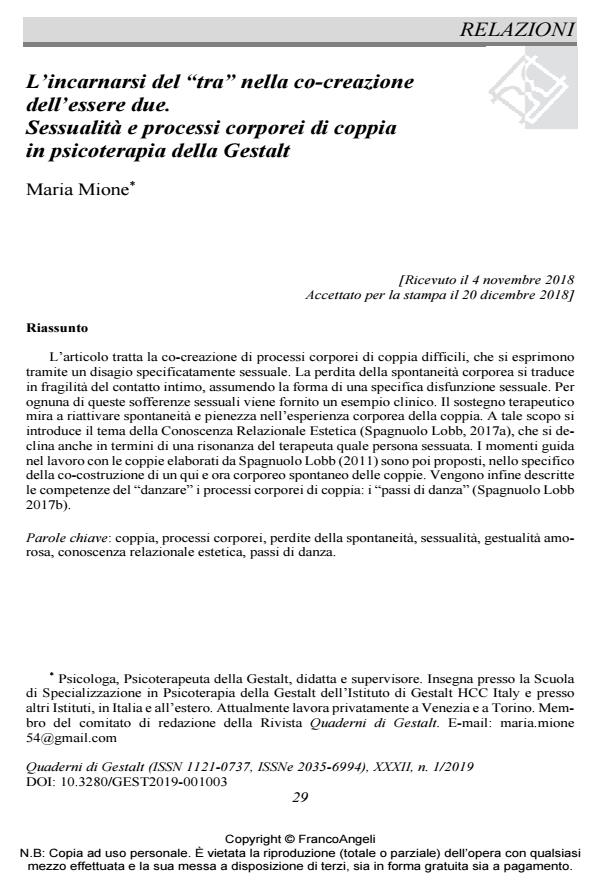The "Between"is Embodied in the Co-creation of Being in two: Sexuality and Embodied Couple Processes in Gestalt Therapy
Journal title QUADERNI DI GESTALT
Author/s Maria Mione
Publishing Year 2019 Issue 2019/1 Language Italian
Pages 28 P. 29-56 File size 275 KB
DOI 10.3280/GEST2019-001003
DOI is like a bar code for intellectual property: to have more infomation
click here
Below, you can see the article first page
If you want to buy this article in PDF format, you can do it, following the instructions to buy download credits

FrancoAngeli is member of Publishers International Linking Association, Inc (PILA), a not-for-profit association which run the CrossRef service enabling links to and from online scholarly content.
In this article, the author will explore the painful embodied couple processes that are ex-pressed through specifically sexual problems. These problems will be viewed as co-created by the couple. The loss of bodily spontaneity results in the fragility of intimate contact, taking the form of a specific sexual dysfunction. According to the Gestalt perspective, suffering belongs to the relationship, not to only one partner: the couple is the main character of these problems. For each of these experiences clinical examples will be given. The author proposes a therapeutic support that can be used to restore spontaneity and full-ness in the embodied experience of the couple. For this purpose, the concept of Aesthetic Re-lational Knowledge of the therapist will be introduced (Spagnuolo Lobb, 2017a). This thera-peutic skill can be viewed also in terms of a resonance of the therapist as a sexual person and is a precious tool in working with embodied processes of the couples in a way that supports the sensitivity of the therapist and at the same time is respectful of the patients’ intimate experi-ence. In addition, the article will introduce specific steps, developed by Spagnuolo Lobb (2011), that guide the work with couples, showing how they can be used by the therapist to support the co-construction of an embodied spontaneity in the here and now of the couple. The final part of the article describes the basic competences implied in the co-construction of the contact that are activated and supported in the therapeutic meeting, in terms of "dance steps", as theorized by Spagnuolo Lobb (2017b), to underline the co-construction of the inter-action. In describing those competences, implied in the process of "dancing" together at the con-tact boundary, the author will focus on how the therapist can promote their development and their growth within the embodied processes of the couple. Thus, the therapeutic setting be-comes a place where one can expand the ground and have new embodied experiences during the therapeutic encounter.
Keywords: Couple, body process, loss of spontaneity, sexuality, love gestures, Aesthetic Rela-tional Knowledge, Dance Steps.
- Bellini B. (2015). Il linguaggio segreto della sessualità. In: Pizzimenti M., a cura di, Aggressività esessualità. Il rapporto figura/sfondo tra dolore e piacere. Milano: FrancoAngeli.
- Ceballos D. (2016). Goodman: Eros, contacto y neurosis. Cuadernos Gestalt, 8: 76-81.
- Cerrini C. (2014). Il contatto come cura delle disfunzioni sessuali della coppia. Quaderni di Gestalt, XXVII, 1: 103-112. DOI: 10.3280/GEST2014-00101
- Fabbrini A. (2000). Tra noi. Psicoterapia di coppia o l’arte di rammentare la crisi. Quaderni di psicologia, analisi transazionale e scienze umane, 31: 34-62.
- Gasparotti R. (2007). Filosofia dell’eros. L’uomo, l’animale erotico. Torino: Bollati Boringhieri.
- Graziottin A. (2006). Il dolore segreto. Le cause e le terapie del dolore femminile durante i rapporti sessuali. Milano: Mondadori.
- Kepner J.I. (1997). Body Process. Il lavoro con il corpo in psicoterapia. Milano: FrancoAngeli (ed. or.: Body Process. Working with Body in Psychotherapy. San Francisco, CA: Jossey-Bass Inc., 1993).
- Lowen A., Lowen L. (1979). Espansione e integrazione del corpo in Bioenergetica. Manuale di esercizi pratici. Roma: Astrolabio Ubaldini.
- Martel B. (2007). Sexualité, Amour et Gestalt. Paris: InterEditions.
- Neruda P. (2007). Neruda. Vita, poetica, opere scelte. Edizione speciale per il Sole 24 Ore, Vicenza, 280-281.
- Perls F. (1995). L’Io, la fame, l’aggressività. Milano: FrancoAngeli (ed. or.: Ego, Hunger and Aggression: A Revision of Freud’s Theory and Method. London: G. Allen & Unwin, 1947; New York: Random Hause, 1969).
- Pizzimenti M., a cura di (2015). Aggressività e sessualità. Il rapporto figura/sfondo tra dolore e piacere. Milano: FrancoAngeli.
- Ravenna A.R. (2015). La vita di coppia. Il legame d’amore tra attaccamento e autonomia. In: Pizzimenti M., a cura di, Aggressività e sessualità. Il rapporto figura/sfondo tra dolore e piacere. Milano: FrancoAngeli.
- Signorelli M.S. (2014). I disturbi sessuali nel DSM 5. Aspetti relazionali tra vecchie e nuove diagnosi. Quaderni di Gestalt, XXVII, 1: 58-63. DOI: 10.3280/GEST2014-001006
- Spagnuolo Lobb M. (2009). L’impossibilità di essere Dei. La Sicilia, rubrica “Vivere”, 25-06-09.
- Spagnuolo Lobb M. (2009a). Sentirsi a casa in terra straniera. La Sicilia, rubrica “Vivere”, 14-05-09
- Spagnuolo Lobb M. (2011). Il now-for-next in psicoterapia: la psicoterapia della Gestalt raccontata nella post-modernità. Milano: FrancoAngeli.
- Spagnuolo Lobb M. (2014). I vissuti sessuali nel setting della psicoterapia della Gestalt post-moderna. Quaderni di Gestalt, XXVII, 1: 19-39. DOI: 10.3280/GEST2014-00100
- Spagnuolo Lobb M. (2015). Dal bisogno di aggressività al bisogno di radicamento: la prospettiva clinica e sociale della psicoterapia della Gestalt post-moderna. In: Pizzimenti M., a cura di, Aggressività e sessualità. Il rapporto figura/sfondo tra dolore e piacere. Milano: FrancoAngeli.
- Spagnuolo Lobb M. (2017a). La conoscenza relazionale estetica del campo. Per uno sviluppo del concetto di consapevolezza in psicoterapia della Gestalt e nella clinica contemporanea. Quaderni di Gestalt, XXX, 1: 17-33. DOI: 10.3280/GEST2017-001003
- Spagnuolo Lobb M. (2017b). From Losses of Ego to the Dance Steps Between Psychoterapist and Client. Phenomenology and Aesthetics of Contact in the Psychoterapeutic field. BritishGestalt Journal, 26, 1: 28-37.
- Essere coppia in-fertile: la riscoperta della vitalità come fattore terapeutico Valentina Foti, Susanna Marotta, in QUADERNI DI GESTALT 2/2024 pp.79
DOI: 10.3280/GEST2023-002006
Maria Mione, L’incarnarsi del "tra" nella co-creazione dell’essere due. Sessualità e processi corporei di coppia in psicoterapia della Gestalt in "QUADERNI DI GESTALT" 1/2019, pp 29-56, DOI: 10.3280/GEST2019-001003